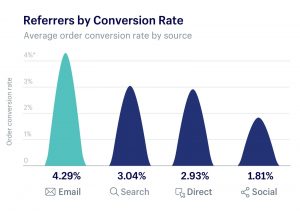— January 19, 2018
If you’re in business and want to be successful (and who doesn’t?) you’re focused on growth. After all, nobody gets into business to shrink their firm. The big question is: How do you drive growth?
There are essentially two kinds of growth—organic and inorganic. The former is built on a complex blend of expertise, experience, reputation, capability and visibility. The latter is a little more straightforward and based on cash, liabilities, and assets.
Organic growth is the “Holy Grail” of professional services marketing. But strategies to drive that growth are often elusive and counter-intuitive. In this post we reveal the top research-based strategies that have proven themselves in real-world, high-growth firms (firms with an average yearly growth rate of at least 20%).
Organic versus inorganic
Organic growth is created by adding new clients or more business from existing clients. It’s essentially expanding your business from within using the resources you have, including skills, knowledge, experience, relationships and other tools. Organic growth is healthy for a firm and reflects a long-term, solid commitment to building a business. It’s not a get-rich-quick approach, however.
Inorganic growth is growth generated by mergers and acquisitions. Inorganic growth relies almost entirely on available resources and capital. Mergers, acquisitions, and their most extreme form, takeovers, can quickly increase a firm’s size and revenue but often mask an underlying weakness.
With that said, let’s focus on organic growth and take a look at five proven strategies for generating it.
1. Research your target clients
It’s surprising how many professional services firms don’t develop a clear picture of their ideal target client and what motivates their decision-making.
Research we’ve conducted for our 2017 High Growth Research Report shows that high-growth firms are twice as likely to conduct systematic research as their no-growth counterparts. As a result, they experience an average yearly growth rate several times higher then their peers.
Research Frequency
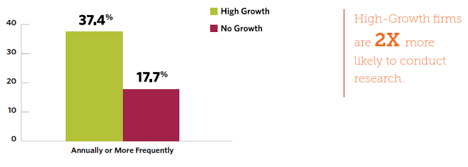
Ask a C-level executive in your average professional services firm who their target client is and he, or she, may only have a vague idea. Research reveals what you don’t know. It also enables you to better focus your marketing efforts based on your target clients’ actual needs and preferences. Insights from research help you better position your firm, reduce the risk of marketing missteps, and develop a competitive advantage.
Once you have established target client preferences through research, you’re able to develop high-value service packages and make a much stronger marketing plan. All because you’ve learned where they get their information, identified their key concerns, and revealed their hot buttons.
Research rocks!
2. Focus on a well-defined niche
With research results in hand, you’re in a position to focus on a specific niche. While some may say it seems counter-productive to narrow your focus (instead of widening it), there are some significant benefits to doing so.
Concentrating on a well-defined niche enables you to reduce marketing costs and competition while increasing market share, fees, and profits. There’s something to be said for being a big fish in a small pond.
In fact, our studies show that high-growth firms are 75 percent more likely to have a highly-focused niche.
Highly-Specialized Firms
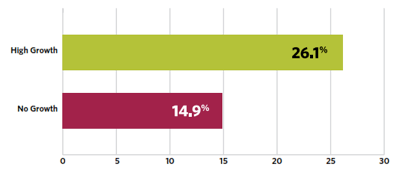
Professional services firms offering everything to everybody typically end up offering little real value to anybody. Their services become generic commodities stuck in a price war with myriad competitors. A slow, painful death often ensues.
3. Develop strong, easy-to-understand differentiators
If your firm is highly specialized or positioned in a well-defined niche, congratulations. You’ve got a built-in differentiator.
What’s a differentiator? It’s a feature or benefit that sets you apart from the competition. Here’s an example: You are an accounting firm but, unlike your competitors, you focus your attention on the specific financial concerns of national chain restaurants. That’s your differentiator.
Firms with unique differentiators have a much easier job communicating their value to prospective clients, setting themselves apart (and above) the competition and winning more business. Our research revealed that high-growth firms are twice as likely as no-growth ones to have easy-to-understand differentiators and 20 percent more differentiators.
Three things make a high-value differentiator:
- Truth
- Relevancy
- Provability
Is what you’re claiming true? Is it relevant to your prospect? Finally, is it provable?
The least effective differentiators are those that offer no direct benefit to the client. No one particularly cares how long you’ve been in business, how many charitable causes you’ve supported, or your claims of having “the best people.”
The best differentiators address the needs and concerns of the prospective client. These include provable claims about how your unique services or expertise can specifically benefit the client.
4. Balance traditional and digital marketing
High-growth firms have a more balanced approach to marketing, mixing digital with traditional. They spend less on traditional and more on digital marketing. In fact, they invest slightly less money and effort than average on marketing overall. And yet they achieve high growth. How is this possible?
Traditional vs. Digital Marketing Effort
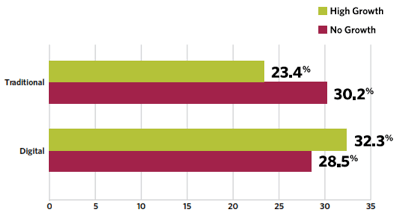
It starts by making sure marketing techniques fit the target audience (potential clients). Here’s where all that research comes in handy. Your data will tell you how your target prefers to receive information. This will go a long way in helping you focus your marketing dollars on the most effective channels.
Tracking your marketing is important, too. High-growth firms commit to tracking their marketing efforts, closely monitoring 33 percent more variables than their slow-growing peers.
Almost every firm tracks the basics such as new clients, revenue, and profitability. However, high-growth firms are also more likely to track variables related to the marketing process.
Metrics Most Often Tracked by High-Growth Firms
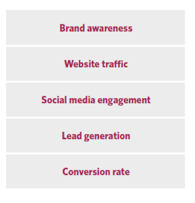
This additional tracking puts firms in a better position to know what works and what doesn’t. This means they are equipped to make course adjustments and fix problems as they arise.
5. Make your expertise visible
As a professional services firm, the only product you have to sell—and what potential clients need to be persuaded to buy—is your collective expertise.
While your expertise has the definite advantage of being unique to your company (there’s that differentiator), it has the drawback of being intangible. Potential clients can’t touch it, taste it, smell it, or see it. The challenge is to make your expertise visible.
This can be done through a carefully targeted and constructed campaign of blogging and article writing, speaking, social media conversations and search engine optimization.
As your firm and its expertise becomes visible in the digital landscape, the pay-offs become enormous.
As the appropriate personnel within your firm become Visible Experts, the firm as a whole gains value in the eyes of potential clients. This value, properly leveraged, leads directly to organic growth. The process is transformative, leading to more visibility which leads to more business.
Conclusion
There’s nothing mysterious about organic growth. There’s a scientific approach to it that requires some homework, discipline, and stick-to-it-ness. Research is key and the driver of a more powerful strategy and more efficient and effective marketing.
Digital & Social Articles on Business 2 Community
(95)
Report Post


